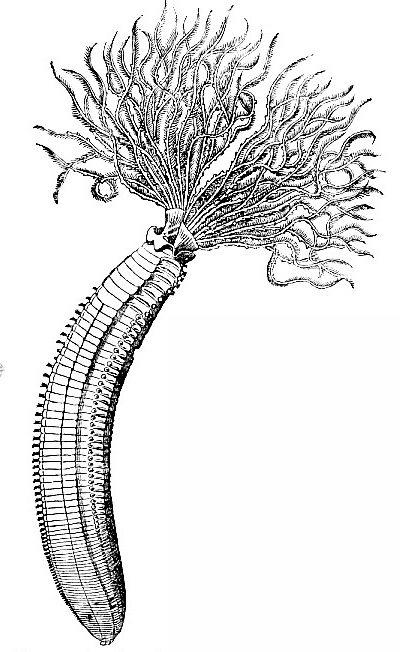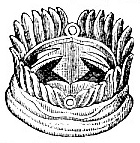1902 Encyclopedia > Annelida > I. Annelida Polychaeta (cont'd): Circulatory System. Branchial Apparatus. Digestive System.
Annelida
(Part 3)
I. Annelida Polychaeta (cont'd)
Circulatory System. Branchial Apparatus. Digestive System.
The circulation of the blood is effected by a system of closed vessels with muscular walls (fig. 5), the fundamental arrangement consisting of a dorsal and a ventral trunk (v), with communicating branches in each segment-the current in the former being directed forwards, and in the latter backwards. Branches from the main trunks ramify on the wall of the alimentary canal, body-wall, dissepiments, and other parts. The dorsal gives branches to the branchiae, whence the blood passes by other twigs to the ventral. Sometimes dilatations, termed "hearts," occur at the bases of the branchiae -- as in Eunice; and in Arenicola and Polyopthalmus similar dilatations exist in other parts. Various modifications of the system take place, such as the bifurcation of the dorsal vessel anteriorly or posteriorly, the presence of blood-sinuses or lacunae round the intestine in certain sedentary forms, and great diversity in regard to capillary distribution. The blood is usually reddish in colour, and devoid of corpuscles -- the latter, however, being present in Syllida, some of the Opheliidae, Cirratulidae, and in Staurocephalus. It is colourless in Aphrodita, greenish in Stylaroides and certain Sabellidae. Finally, Glycera and Polycirrus are devoid of a true circulatory apparatus. This system is compared by Professor Huxley to the water-vascular system of the Echinoderms, Trematoda, and other groups; but, as formerly mentioned, this is doubtful. Haemoglobin has been found by Ray Lankester in the blood of many of the Polychaeta.

Fig. 6 -- Dasychone infracta, Kr. (After Malmgren.)
The Annelida composing this group generally possess a special branchial apparatus, and where this is absent (e.g. Lumbriconereis), the skin and ciliated digestive chamber seem to carry on the function. So characteristic are the branchiae, that the term Dorsibranchs was aptly bestowed on one section (see fig. 4), and Cephalobranchs on the other (see fig. 6). The branchiae have the form of simple filiform organs, or they are pinnate, bipinnate, pectinate (e, fig. 4), flabelliform, or arbuscular processes. To each the blood is carried by a branch of the dorsal vessel, which traberses the organ to its extremity, and, looping, carries the aerated fluid to the ventral vessel. Vascular loops pass between the two branches in the branchiae, and only very thin cuticular tissues covered with cilia intervene between the water and the blood, so that due oxygenation occurs. In the Serpulidae the branch from the dorsal vessel is continued directly into the twig going to the ventral, and from their point of union a single vessel traverses the branchia and sends processes into the pinnae, the blood, moreover, in these presenting undulatory movements. A cartilaginous framework exists in the branchial processes of the latter group and the Sabellidae (fig. 6). According to Fritz Muller the opercular plug in certain forms is developed by a gradual metamorphosis of the branchia.

Fig. 7 -- Tip of proboscis and horny teeth of Polynoë impatiens (After Savigny.)
The digestive system consists of a rounded alimentary canal, commencing at the second and terminating in an anus at the last or the penultimate segment. The mouth opens in the form of a simple slit or grooved dimple on the under surface of the second segment. In many the first region is a complex muscular and protrusible proboscis (fig. 5, a pharunx and oesophagus of some, and the osesophagus of others), with papellae, horny or dense calcareous teeth (fig. 7), with a narrow osesophageal region (a) behind. Certain glandular organs in the oesophageal region of certain forms are termed salivary. The walls of the succeeding portion (a") are often marked by numerous sacculations from constrictions at the dissepiments; and in some (e.g., Aphrodita) large diverticula occur. The inner surface bears vibratile cilia, the walls are glandular, and there are also circular and longitudinal muscular fibres. The gland-cells contain numerous refracting granules, and the tissue is by some held to be homologous with the liver of the higher forms. Many modifications of this system exist: thus, for example, there is in Syllis a firm, smooth anterior region (lharynx), often armed, then a region provided with glands (proventriculus or gizzard), a stomach with a glandular sac on each side, and lastly the intestine. The food of the group consists of both animal and vegetable substances, and sandy mud is swallowed by others for the nutrient particles it contains.
Read the rest of this article:
Annelida - Table of Contents
|

